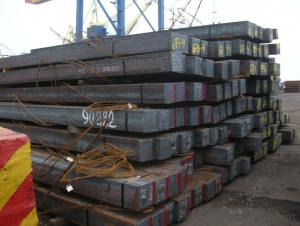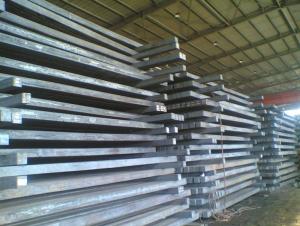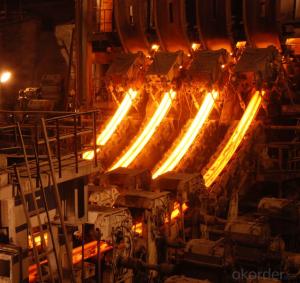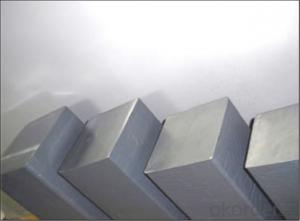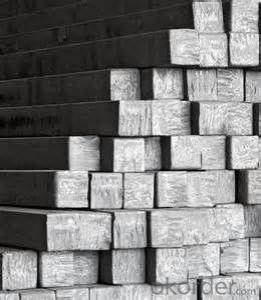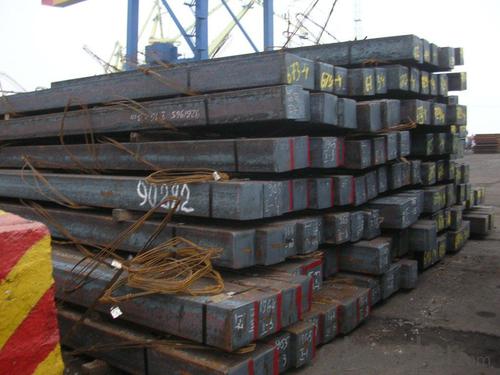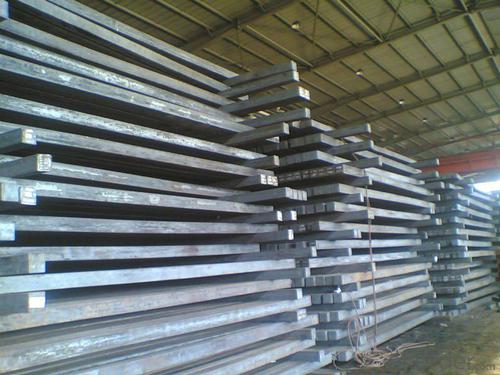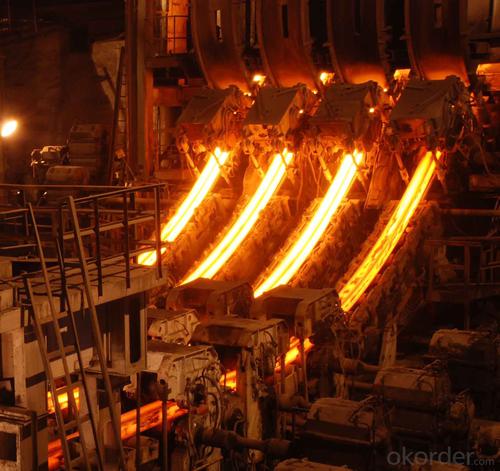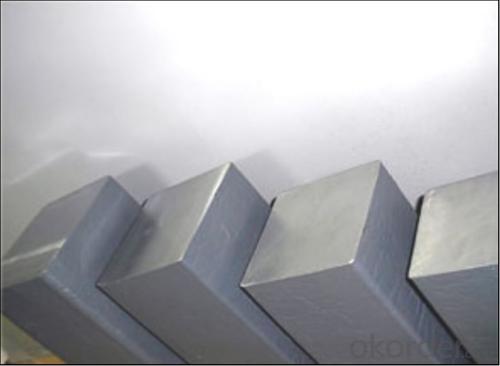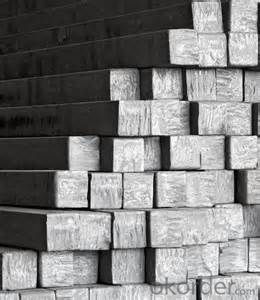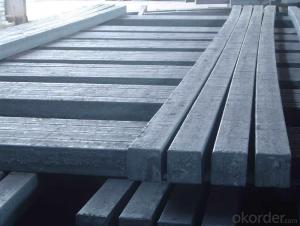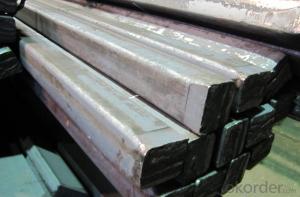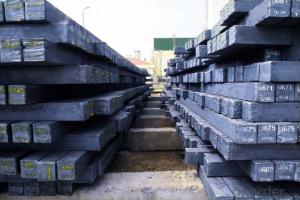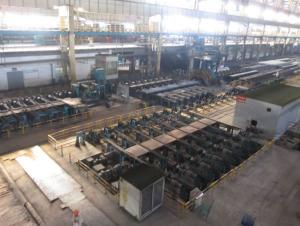Square Steel Billet Q235 3SP Grade Prime Quality 12#
- Loading Port:
- Tianjin
- Payment Terms:
- TT OR LC
- Min Order Qty:
- 2000 m.t
- Supply Capability:
- 50000 m.t/month
OKorder Service Pledge
OKorder Financial Service
You Might Also Like
Description of Square Steel Billet Q235 3SP Grade Prime Quality 12#
M. S. Billets are used for rolling of TMT Re-Bars of Fe415 and Fe500 Grade and various other structural steel products.
CRS Billets are used for rolling of CRS TMT Re-Bars.
Special Alloy Billets are used for rolling of any special grade TMT Re-Bars like Earthquake resistant TMT Re-Bars and for special grade structural steel products.
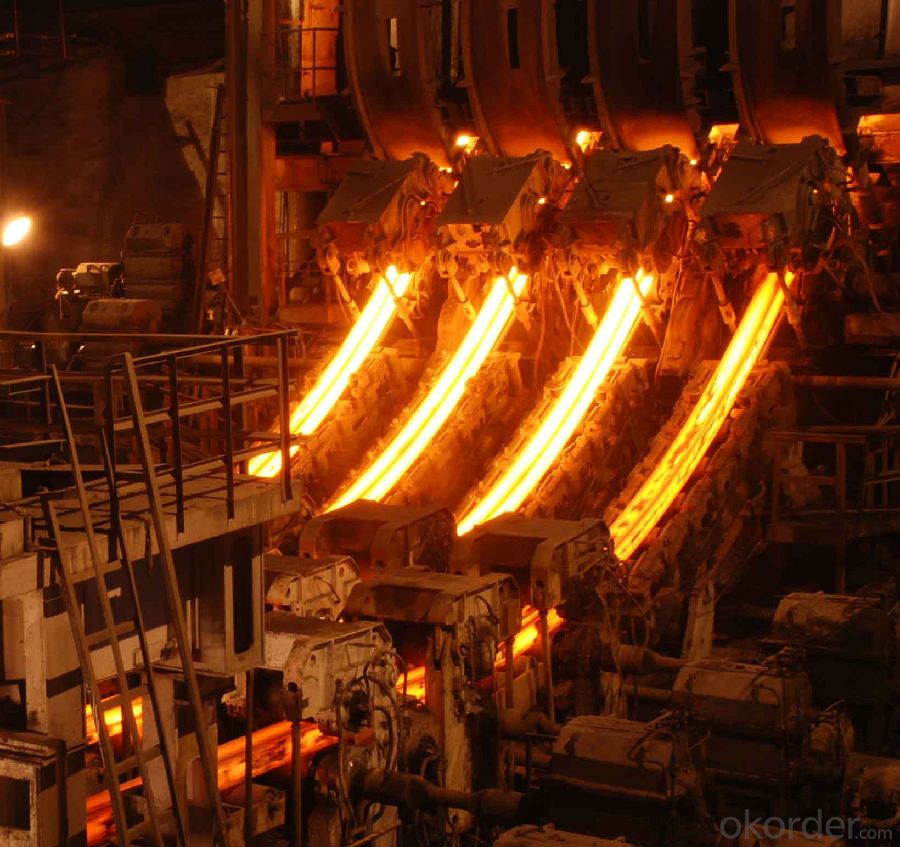
Main Feature Square Steel Billet Q235 3SP Grade Prime Quality 12#
Raw elements(C,Fe,Ni,Mn,Cr,Cu.)---Smelted ingots by AOD finery---hot rolled into black suface---pickling in acid liquid---cold drawn----polished by automatically machine--- cutting into pieces---checking quanlity
Applications of Square Steel Billet Q235 3SP Grade Prime Quality 12#
Widely Used in the areas such as Stainless Steel Fasteners, Chains, Kitchen and Sanitary wares, Furniture handles, Handrails, Electroplating and Electrolyzing pendants, Foods, Electron, Petroleum, Construction and Decoration, etc. Products have a high strength after cold-working. Electronic products parts, Medical appliance, Springs, Bus Inside and Outside packaging and building, Street Lamp Posts, etc. Decoration materials and Outdoor Publicity Billboard. Used for the products which have the Anti-Stress Corrosion requirement. Electron Products, Table-wares, Bolts, Nuts, Screen Meshes, Cumbustors and so on.
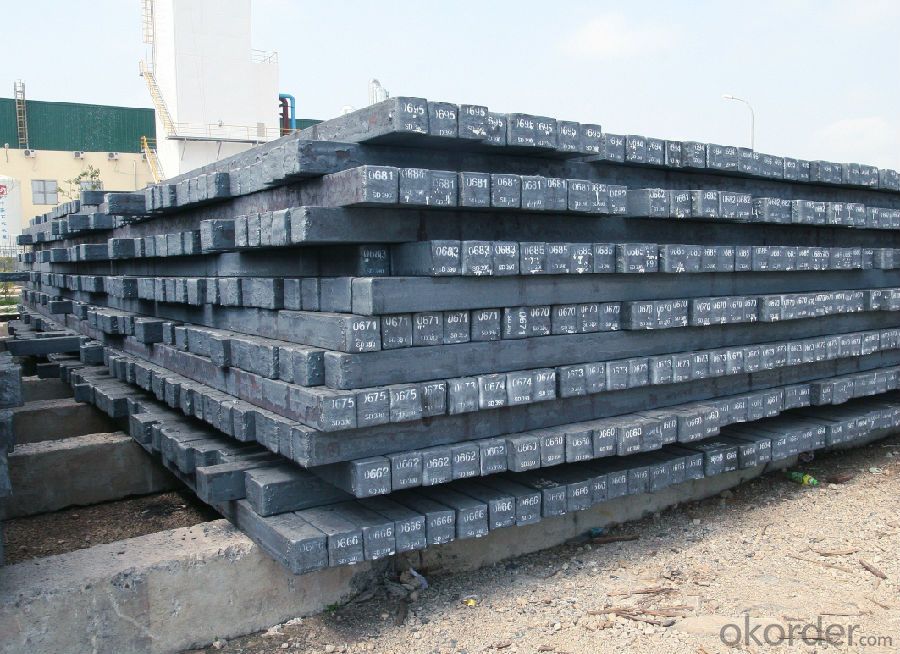
Specifications of Square Steel Billet Q235 3SP Grade Prime Quality 12#
| Standard | C(%) | Mn(%) | S(%) | P(%) | Si(%) |
| Q195 | ≤0.12 | ≤0.50 | ≤0.040 | ≤0.035 | ≤0.30 |
| Q235 | ≤0.20 | ≤1.40 | ≤0.045 | ≤0.045 | ≤0.35 |
| Q275 | ≤0.22 | ≤1.50 | ≤0.045 | ≤0.045 | ≤0.35 |
| 20MnSi | 0.17-0.25 | 1.2-1.6 | ≤ 0.050 | ≤ 0.050 | 0.40-0.80 |
| 3SP | 0.14-0.22 | 0.40-0.85 | ≤ 0.050 | ≤ 0.040 | 0.05-0.15 |
| 5SP | 0.28-0.37 | 0.50-1.00 | ≤ 0.050 | ≤ 0.040 | 0.15-0.30 |
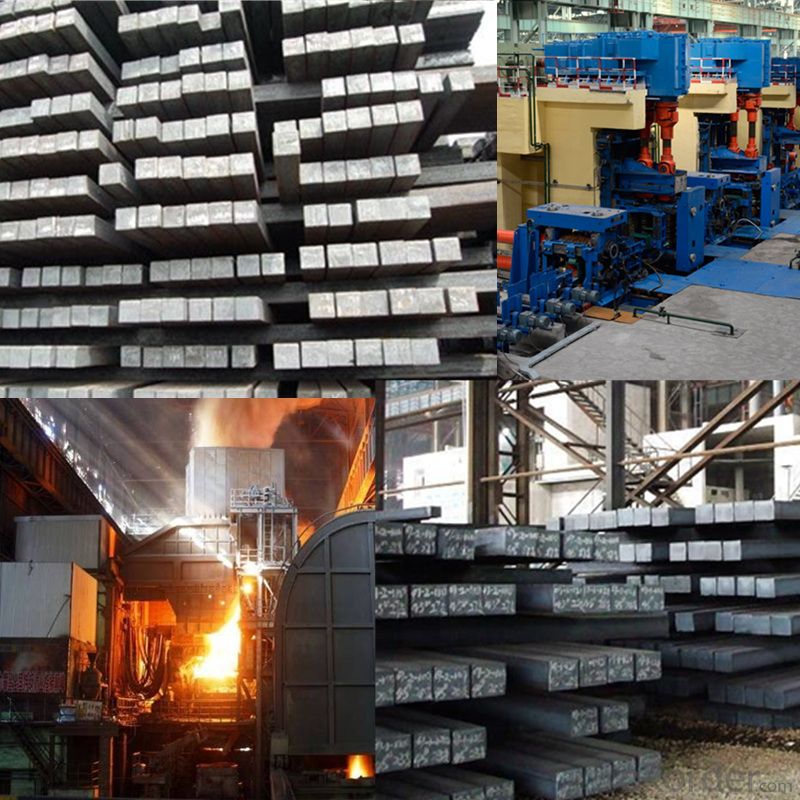
FAQ of Square Steel Billet Q235 3SP Grade Prime Quality 12#
We have organized several common questions for our clients,may help you sincerely:
1. How Can I Visit There?
Our company is located in Tianjin City, China, near Beijing. You can fly to Tianjin Airport Directly. All our clients, from home or aboard, are warmly welcome to visit us!
2. How Can I Get Some Sample?
We are honored to offer you sample.
3. Why choose CNBM?
Our delivery time about 15-20days for standard sizes, if you have other requirements like hardness, quanity and width ,it is about 20-40days. But don't worry we also try our best for the delivery time ,because time longer and our cost is higher.
- Q: How has the demand for steel billets changed over time?
- The demand for steel billets has changed over time due to various factors, including economic conditions, infrastructure development, and technological advancements. In recent years, the demand for steel billets has generally been on the rise as countries invest in construction projects, manufacturing, and automotive industries. However, there have been fluctuations in demand based on global economic trends, such as the impact of the COVID-19 pandemic. Overall, the demand for steel billets has evolved to meet the changing needs of industries and remains an essential component in various sectors.
- Q: What are the common applications of steel billets?
- Steel billets are commonly used as raw material for the production of various steel products, such as bars, rods, wire, pipes, and tubes. They are also utilized in the automotive industry for manufacturing parts like crankshafts, camshafts, and gears. Additionally, steel billets find applications in construction for producing structural elements like beams, columns, and girders.
- Q: How do steel billets contribute to the manufacturing of kitchen appliances?
- Steel billets are an essential component in the manufacturing of kitchen appliances. These billets, which are semi-finished steel products, are typically in the form of a rectangular or square shape and are produced through a process called continuous casting. The first way steel billets contribute to the manufacturing of kitchen appliances is by serving as the primary raw material for the production of various appliance components. For example, kitchen appliances such as stoves, ovens, refrigerators, and dishwashers require a sturdy and durable structure, and steel billets provide the necessary strength and resilience. The billets are processed further through various techniques like hot rolling, forging, or extrusion to form specific appliance parts such as frames, doors, panels, and handles. Secondly, steel billets play a crucial role in ensuring the longevity and reliability of kitchen appliances. Steel, known for its high tensile strength and resistance to corrosion, allows manufacturers to create appliances that can withstand the rigors of daily use and last for a long time. By using steel billets as the base material, kitchen appliances can withstand high temperatures, heavy loads, and harsh environments without compromising their structural integrity. Furthermore, steel billets contribute to the aesthetics of kitchen appliances. The smooth and polished surface of steel provides an attractive finish and modern look to appliances, making them visually appealing to consumers. Steel can also be easily manipulated to achieve different shapes and designs, allowing manufacturers to create sleek and stylish appliances that complement the overall kitchen decor. In addition to these factors, steel billets have excellent heat conductivity properties, which is vital for kitchen appliances like stoves and ovens. The even distribution of heat throughout the appliance ensures efficient cooking and baking, ensuring that food is cooked thoroughly and evenly. Overall, steel billets are integral to the manufacturing of kitchen appliances due to their strength, durability, aesthetics, and heat conductivity properties. Without these billets, it would be challenging to produce high-quality, reliable, and visually appealing kitchen appliances that meet the demands of consumers.
- Q: What is the difference between hot-rolled and cold-rolled steel billets?
- Hot-rolled steel billets and cold-rolled steel billets are two types of steel that undergo different manufacturing processes, resulting in distinct characteristics and properties. When producing hot-rolled steel billets, the steel is heated to a high temperature and then rolled while still hot. This process allows for easy shaping and forming into various sizes and shapes. Additionally, hot-rolling creates a rough surface finish and a scaled outer layer due to exposure to high temperatures. Generally, hot-rolled steel billets have a larger grain structure, which can result in a less precise and uniform final product. However, they also possess improved mechanical properties, such as higher strength and toughness, making them suitable for applications where strength is important, but surface finish is not a priority. In contrast, cold-rolled steel billets are produced by cooling the steel to a low temperature and rolling it at room temperature. This process allows for tighter dimensional tolerances and a smoother surface finish compared to hot-rolled steel billets. Additionally, cold-rolling results in a more refined grain structure, which enhances the overall strength, hardness, and durability of the steel. Cold-rolled steel billets are commonly used in applications where precise dimensions, surface finish, and uniformity are required, such as in the automotive, construction, and appliance industries. To summarize, the main difference between hot-rolled and cold-rolled steel billets lies in the manufacturing processes and resulting properties. Hot-rolled steel billets are formed at high temperatures, resulting in a rough surface finish and larger grain structure. Cold-rolled steel billets, on the other hand, are formed at room temperature, leading to tighter dimensional tolerances, a smoother surface finish, and a more refined grain structure. The choice between hot-rolled and cold-rolled steel billets depends on specific requirements and applications, with hot-rolled steel billets being preferred for their superior strength and cold-rolled steel billets for their precise dimensions and surface finish.
- Q: The role of carbon content in steels
- 2., the formation of carbide structure, can improve the hardness and wear resistance of steel, such as cementite, or Fe3C, that is, carbide organizationTherefore, the higher the carbon content in carbon steel, the higher the strength and hardness of the steel, but the plasticity and toughness will also be reduced. On the contrary, the lower the carbon content, the higher the plasticity and toughness of the steel, and its strength and hardness will also decrease
- Q: What is the role of steel billets in the production of wire rods?
- Wire rods depend greatly on steel billets for their production. These long, cylindrical metal rods are widely utilized in construction, automotive, and manufacturing industries. To begin the production process of wire rods, steel is melted in either an electric arc furnace or a basic oxygen furnace. Once the desired temperature and composition are achieved, the molten steel is poured into molds, resulting in the formation of steel billets. Steel billets act as semi-finished products that serve as the initial stage in the wire rod manufacturing process. These solid bars of steel, which can be rectangular or round, undergo further processing to be transformed into wire rods. The conversion of steel billets into wire rods commences with a reheating process. The billets are subjected to high temperatures, making them more malleable and easier to manipulate. This reheating process is typically carried out in a reheat furnace. Following reheating, the billets are passed through a series of rolling mills. This reduces their size and shapes them into wire rods. These rolling mills apply a combination of pressure and heat to deform the steel billets, elongating them into long, thin rods. This rolling process also enhances the mechanical properties of the wire rods, such as their strength and flexibility. Once the wire rods are formed, they may undergo additional treatments, including cooling, surface treatments, and quality inspections. These treatments are necessary to meet the specific requirements of different applications. The wire rods can then be further processed into various products, such as wires, cables, reinforcement bars, or other specialized components. In conclusion, steel billets are a critical component in the production of wire rods. They serve as the starting material, undergoing various processing steps, such as reheating and rolling, to achieve the desired shape and properties of wire rods.
- Q: How do steel billets contribute to the manufacturing of household appliances?
- Steel billets play a crucial role in the manufacturing of household appliances. These billets serve as the raw material for the production of various components and structures used in household appliances. Firstly, steel billets are used to manufacture the frames and structures of appliances such as refrigerators, washing machines, and dishwashers. The high strength and durability of steel make it an ideal choice for these applications, ensuring that the appliances can withstand the constant use and heavy loads they encounter. Secondly, steel billets are used to produce the inner and outer panels of household appliances. These panels require a material that is strong, resistant to corrosion, and aesthetically pleasing. Steel fits these criteria perfectly, providing a sleek and durable surface that can be easily cleaned and maintained. Additionally, steel billets are used to create various components within household appliances, including heating elements, motors, and electrical parts. Steel's excellent thermal conductivity and electrical properties make it a suitable material for these critical components, ensuring efficient operation and reliable performance. Furthermore, steel billets contribute to the overall safety of household appliances. Steel is a fire-resistant material, reducing the risk of accidents caused by overheating or electrical malfunctions. Its strength and stability also play a role in preventing structural failures that could lead to accidents or injuries. In summary, steel billets are essential in the manufacturing of household appliances due to their strength, durability, corrosion resistance, and thermal/electrical properties. By providing the necessary raw material, steel billets enable the production of robust structures, aesthetic panels, critical components, and safe appliances that meet the demands and expectations of consumers.
- Q: How are steel billets used in the manufacturing of industrial machinery parts?
- Steel billets are used in the manufacturing of industrial machinery parts as they serve as the raw material for shaping and forming various components such as gears, shafts, and frames. These billets are heated and then passed through a series of processes like forging, machining, and welding to create the desired shape and size required for the machinery part. The strength and durability of steel make it an ideal material for industrial machinery, ensuring reliable performance and longevity.
- Q: What are the different methods of steel billet surface plating?
- There are several different methods of steel billet surface plating, each with its own advantages and applications. Some of the most common methods include: 1. Electroplating: This is a widely used method where an electric current is used to deposit a layer of metal onto the surface of the steel billet. The billet is submerged in a solution containing metal ions, and when the current is applied, the metal ions are attracted to the steel surface, forming a thin coating. 2. Hot-dip galvanizing: In this method, the steel billet is dipped into a bath of molten zinc. The high temperature causes the zinc to bond with the steel, forming a protective layer. This process is commonly used for steel structures that will be exposed to harsh environments or corrosive elements. 3. Powder coating: This technique involves applying a dry powder to the surface of the steel billet, which is then heated to form a protective layer. Powder coating offers excellent durability, resistance to corrosion, and a wide range of color options. 4. Physical vapor deposition (PVD): PVD is a method where a thin film of metal is deposited onto the surface of the steel billet through a physical process such as evaporation or sputtering. This technique is commonly used for decorative purposes and to enhance the hardness and wear resistance of the steel surface. 5. Chemical conversion coating: This process involves treating the steel billet with a chemical solution that forms a protective layer on the surface. Common conversion coatings include phosphate and chromate coatings, which provide corrosion resistance and improve paint adhesion. 6. Thermal spraying: In this method, a heated material, typically a metal or ceramic powder, is sprayed onto the steel billet surface using a high-velocity gas or flame. The sprayed material forms a coating, providing enhanced protection against wear, corrosion, and high temperatures. Each of these methods has its own benefits and is suitable for different applications. The choice of plating method depends on factors such as the desired level of protection, cost, aesthetics, and specific requirements of the steel billet's end use.
- Q: Can steel billets be used in the production of industrial equipment?
- Yes, steel billets can be used in the production of industrial equipment. Steel billets are semi-finished metal products that can be further processed to create various types of industrial equipment such as machinery, tools, automotive parts, construction materials, and more. The high strength, durability, and versatility of steel make it an ideal material for manufacturing industrial equipment. Steel billets can be shaped, machined, and welded to create complex structures and components, providing the necessary strength and stability required for industrial applications. Additionally, steel billets can be heat-treated to enhance their mechanical properties, making them even more suitable for use in heavy-duty industrial equipment.
Send your message to us
Square Steel Billet Q235 3SP Grade Prime Quality 12#
- Loading Port:
- Tianjin
- Payment Terms:
- TT OR LC
- Min Order Qty:
- 2000 m.t
- Supply Capability:
- 50000 m.t/month
OKorder Service Pledge
OKorder Financial Service
Similar products
Hot products
Hot Searches
Related keywords
